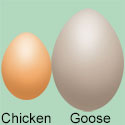
Goose eggs are delicious! Just one egg makes a formidable omelet, although goose eggs are less often used for culinary purposes than for hatching or — because of their large size and thick shells — for creating goose egg craft items such as Christmas ornaments and decorative jewelry boxes. Yet goose eggs may be used in just about any recipe calling for eggs and are especially suitable for baking rich pastries.
Although female geese don’t lay as many eggs per year as a chicken or a duck, they may continue laying reasonably well for longer in life — as much as eight years for some. Goose eggs are nearly three times the size of a chicken egg, the white is somewhat thicker, and the yolk makes up nearly half the contents.
The best way to substitute goose eggs for chicken eggs in a recipe is by determining the egg’s contents using measuring spoons and cups. Each medium size chicken egg is about 3 tablespoons or 1.5 liquid ounces; a large egg is 3¼ tablespoons or about 1.6 liquid ounces; an extra-large egg is 4 tablespoons (¼ cup) or 2 liquid ounces. A recipe calling for 4 large eggs, for example, would require 13 tablespoons (or about 6½ liquid ounces) of goose eggs.
The primary problem with keeping geese for their eggs is that they lay seasonally. In a warm climate, geese may start laying toward the end of January. In a cold climate they may not start until early March. Once they start laying, most hens produce an egg a day. How many eggs a goose lays in a season depends on the goose breed. The general range for annual goose egg production is between 15 and 50 eggs.
Age is another consideration. A goose hen’s egg production peaks at three to five years, then gradually declines. A third consideration is climate. As cool-weather birds, geese generally prefer to lay only as long as daytime temperatures remain below about 80°F.
A typical backyard scenario is that a goose will lay a dozen or so eggs in early spring, then decide to hatch them, at which time she stops laying. To extend the laying period and increase the number of eggs you can use for culinary purposes (or hatch in an incubator), avoid letting eggs accumulate in the nest. Removing eggs from the nest each day will encourage your geese to continuing laying a little while longer.
And that’s today’s news from the Cackle Coop.
Gail Damerow is editor and principal author of Backyard Homestead Guide to Raising Farm Animals.

